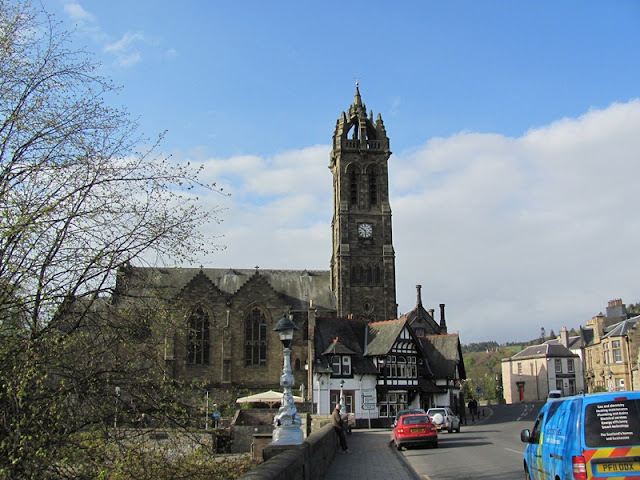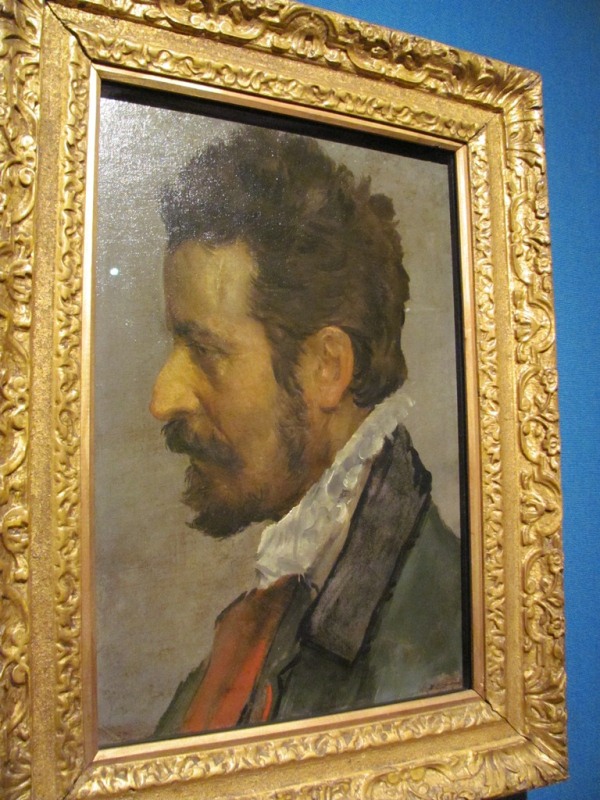Here I am in my shirt sleeves, next to an open window, writing at the end of May about a small trip we made at the beginning of the month. Don't be fooled by the blue skies in some of these photos, it was distinctly chilly still. The weather had actually improved somewhat from an hour or so earlier when we were at Traquair House and rather than risk driving straight back into the Edinburgh rush hour, we stopped in Peebles for a little while.
The first thing we found when we wandered onto the High Street was this statue of three salmon swimming upstream. Three salmon appear all over the town as a feature on the town's coat of arms.
This lion we spotted is holding a shield with the salmon in their more traditional arrangement. One of the salmon is seen swimming against the flow which couples up with the town motto, Contra Nando Incrumentum which means, "there is increase in swimming against the stream" or in a slightly better sounding translation, "Against the tide, we flourish."
The copper domed shelter seen here in the courtyard of the Chambers Institute is the Peebles war memorial.
Built to a design by Burnett Orphoot who won a competition to design it in 1919. At £6500 pounds it was a little over budget. They do though have one of the best war memorials I have seen for their money to remember the 541 people killed in the first world war and 110 in the second.
There's a little film of Earl Haig opening it in 1922 here
We went for a wee wander down by the River Tweed where we spotted this heron.
Just outside the town is Neidpath Castle. The tower dates back to the 14th century and has been visited by Mary Queen of Scots and James VI. During Cromwell's excursions into Scotland, in the 17th century, Neidpath Castle held out against him longer then any other castle in the south of Scotland.
It could do with a bit of patching up in places now.
Here's a chap trying his hand at catching some of those famous salmon - I don't suspect he's all that bothered whether they are going up or down stream.
We walked as far as the Neidpath viaduct before crossing over and walking back into town.
It was built in 1863 and I do hope my pictures have managed to capture it's fascinating shape. It goes across the Tweed at an angle and with a slight curve but each arch is skewed so that it is in line with the flow of the river.
Just after the viaduct we found this railway tunnel.
I wandered in as far as I could see and took this photo, of what looked like complete darkness, with my flash on. It really was very dark and we didn't have a torch. Rather disconcertingly, we did have a camera which when pointed into the dark suddenly said, "face recognition on"!!
Turning round looked like a better route. A small investigate tells me
that the tunnel is about half a mile long and has a bend in the middle
which is why you can't see any light at the end of the tunnel. Built in
1853 and used until 1954, the tunnel was also used in the early part of the 20th century by the Scottish Nobel winning physicist CTR Wilson for his experiments to prove or disprove the existence of cosmic rays with his cloud chamber. It was also used to house the royal train during the second world wars when the King and Queen were examining blitz damage on Clydeside.
Back into the light and a view of Neidpath Castle again, this time from the other side of the river.
And just before we arrived back in Peebles for a much needed visit to the fish and chip shop, a last shot of the river where a bunch of local kids were using it to canoe on.

























































